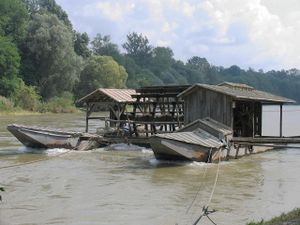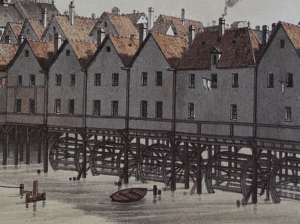Boat and bridge mills
Boat and bridge mills are types of mills used predominantly in Eastern Soltenna, particularly Loheta, and alongside the river Ersaj in northern Ystel. Boat mills have the mill wheel attached to one or two boats, while in bridge mills the wheel is lowered into the water from below a bridge. Boat mills are characterized by a floating wheel that is able to adapt to various water levels, which bridge mills do by using stationary wheels that can be adjusted to account for rising or falling water. This contrasts with watermills with a fixed wheel that require a certain water level to be effective.
Construction
Boat mills usually consist of two hulls with a huge, powerful water wheel in the middle, up to five meters in diameter, continuously delivering the equivalent power of up to five horses almost every day regardless of weather. The only time they can not operate is during freezing temperatures and heavy storms, with them needing to be brought onto land or into sheds to not risk having them unmoor and damage themselves and objects in their surroundings. The flour is then shipped via smaller boats to its final location, or with boat mills moored near the riverside, simply carried ashore with the help of a bridge, on the back of workers or pack animals.
Bridge mills move the water wheels to below arched bridges where they would run at higher speeds, and several wheels could be operated side by side, lowered and raised as needed. This model allowed the use of riverside territory for other purposes, while still keeping the mills inside the city to keep transport distances safe and short
History
Boat mills
Boat mills have been in use in Loheta for more than a millennia, invented possibly in the 8th century. They are valued for working at any water level and being able to be easily relocated alongside rivers, as unlike conventional watermills such floating mills rose and sunk with the water level of a river. Furthermore, they also can be relocated to wherever the water was flowing the fastest or flour was needed the most, while freeing up space at river shores.
This changed with the contact between South Jute and Loheta at the end of the 19th century, shortly after the country had become independent again. This contact not only meant regular trade and visits, but also led to technology exchanges. Boat mills quickly became widespread, as milling had traditionally been a very labor-intensive process in South Jute and much of Ystel. Windmills remained unknown until the industrial revolution brought in new technologies and experties from overseas. Undershot watermills, invented in Gfiewish chiefdom of Slakkariew in 10th century, had due to the remoteness of most rural South Jutean communities only featured in settlements with regular contact to Gfiewish towns as well as the capital Laina, which were located alongside the largest river of Ystel, the Ersaj. Most other regions saw milling be done exclusively manually using grindstones of various sizes.
As undershot watermills have several problems inherent to them, being reliant on the flow speed of the river they were located at, and being inoperable if following heavy rains or periods of drought the water level of a river was higher or lower than usual. This was particularly common in larger rivers, such as the Ersaj, where the wheels of water mills would often have to stand still as a result. Furthermore, they could not be built at or near the seacoast and use up valuable riverside real estate in towns, limiting their number. As a result, even settlements with water mills would often result to manual grinding, especially during times of foreign rule.
The introduction of boat mills saw their quick spread on South Jutean coasts and rivers, such as the Bay of Laina, the Ersaj and many smaller rivers. They provided various villages with a more convenient, far less labor-intensive and reliable source of e.g. millet flour, one of the staple flours of the country.
Bridge mills
Laina and some riverside villages remained the exception, as about the same time they had started to use bridge mills, building on the existing water mill. Bridge mills freed up valuable riverside real estate, made it impossible for millers to evade local tax authorities, and also kept the river from being crowded with boat mills.
To not block river traffic on what was the most important trade artery of the continent, the middle arches were kept free and most milling wheels could be moved out of the water entirely and disappear into the mill built on top of the bridge. The idea soon spread up the river to towns in Gfiewistan, but as it required a large streams and high, arched bridges to operate effectively they were not cost-effective for the many smaller villages of South Jute, which continued to use boat mills.
Modern times
Although some mills of these two types have been replaced by windmills and mills powered by electricity, both remain in use today as they are seen as clean, more sustainable options that work with nature, rather than against it, as opposed to e.g. hydroelectric dams or fossil fuel power stations do. The former take up massive amount of space, flooding a lot of land, harming ecosystems and blocking river traffic, while the latter are very polluting and require permanent costly imports.
As a result, the mills are popular with local environmental groups as much as with the general population, who view them as public heritage, and businesses, who see them as profitable and reliable if properly maintained. Upgraded boat and bridge mills, often now outfitted with steel wheels, can grind up to ten tons of flour in 24 hours, enough to feed approximately 25,000 people. A country as South Jute with about a million inhabitants only needed about 40 of them to sustain itself, and that is not counting flour ground by other mills or imported from other countries, thus reducing the dependency on and amount of electricity that needs to be imported or generated from other sources.

